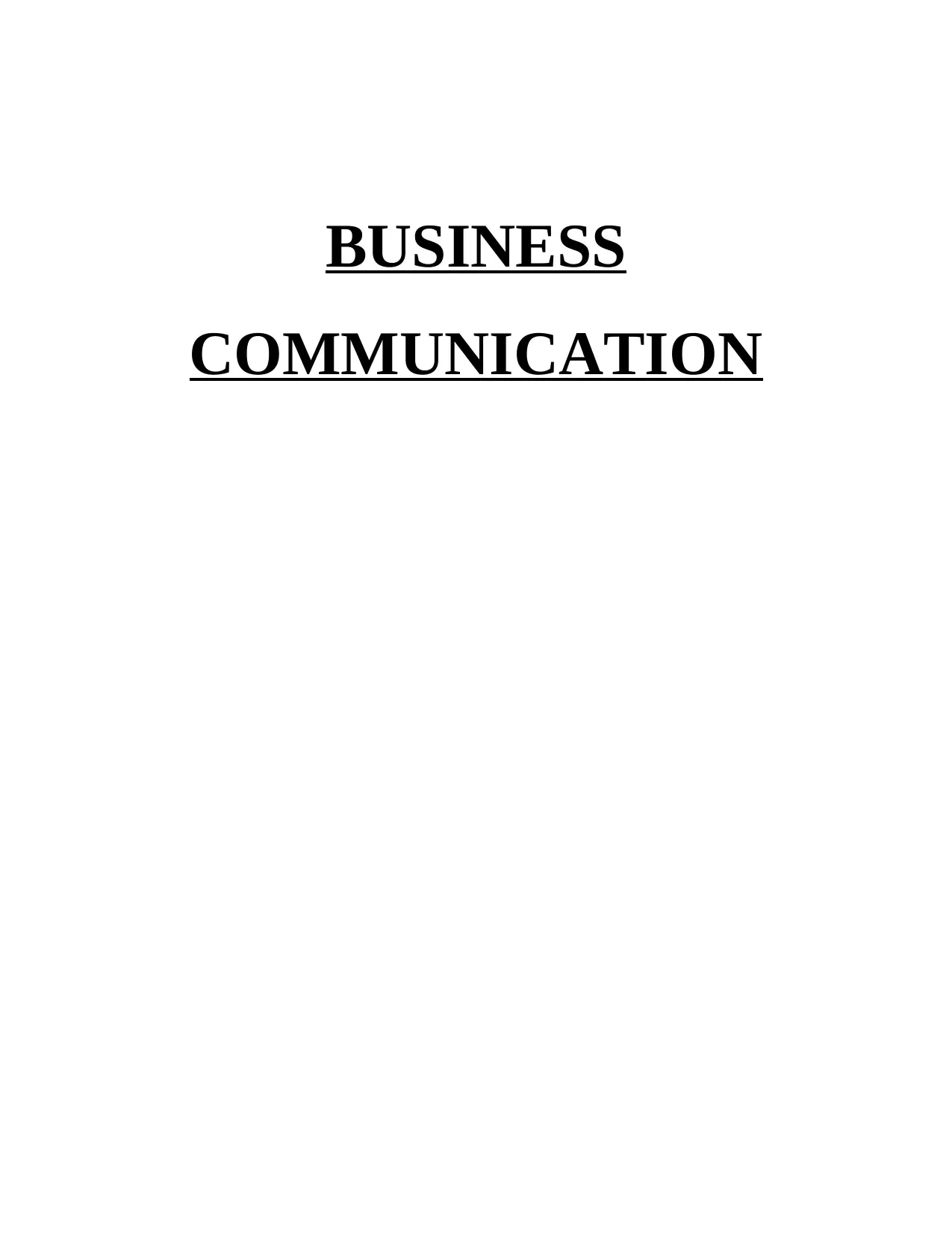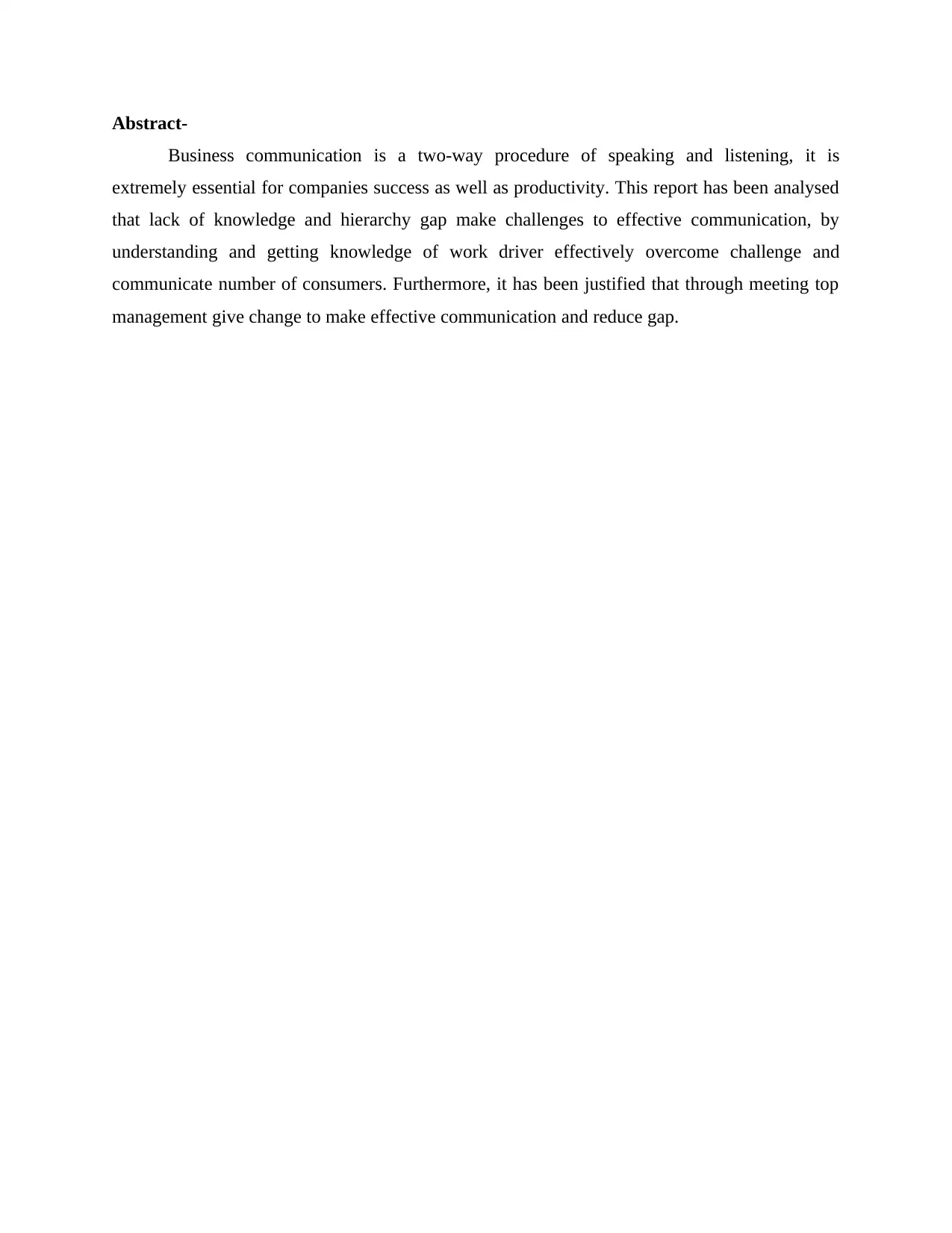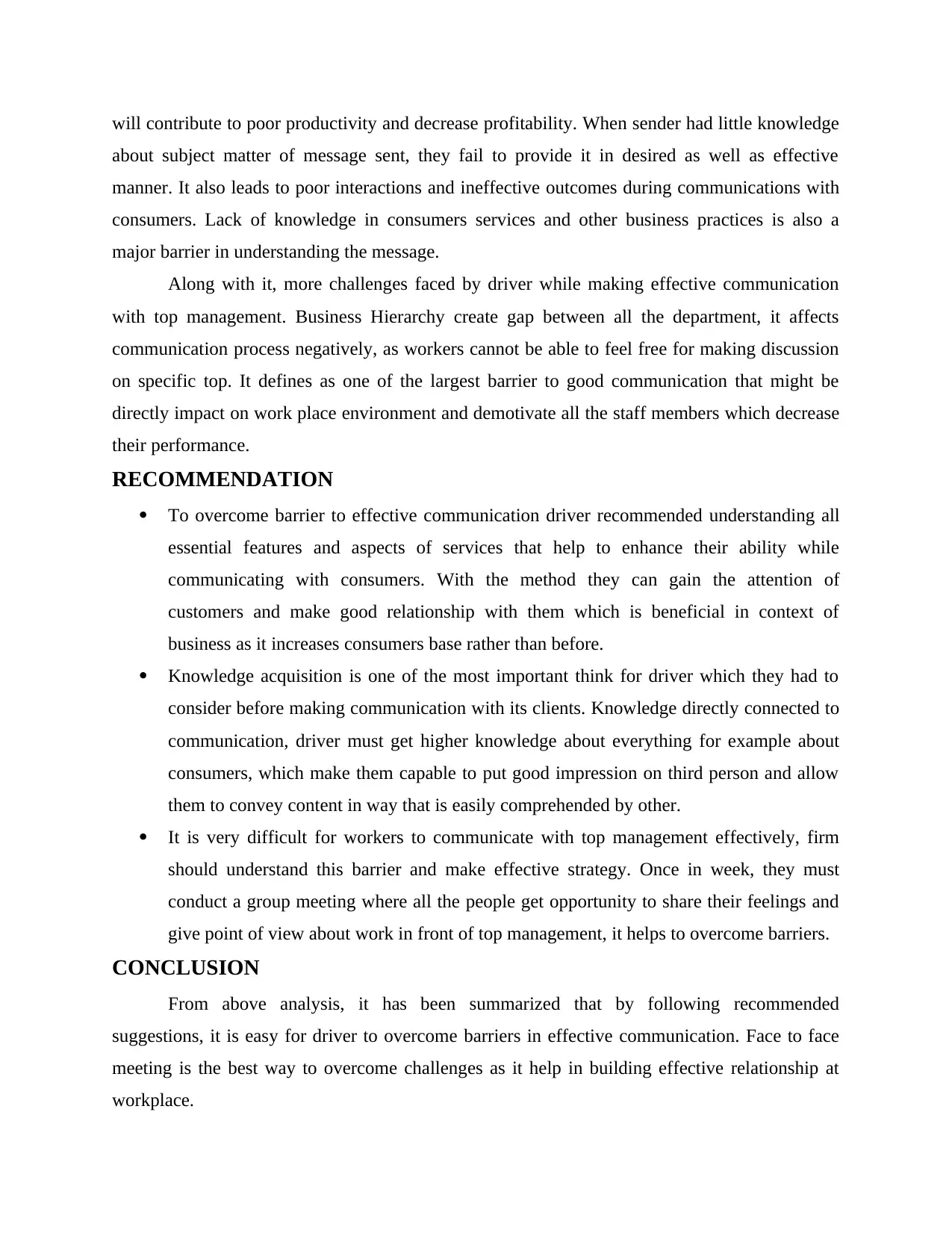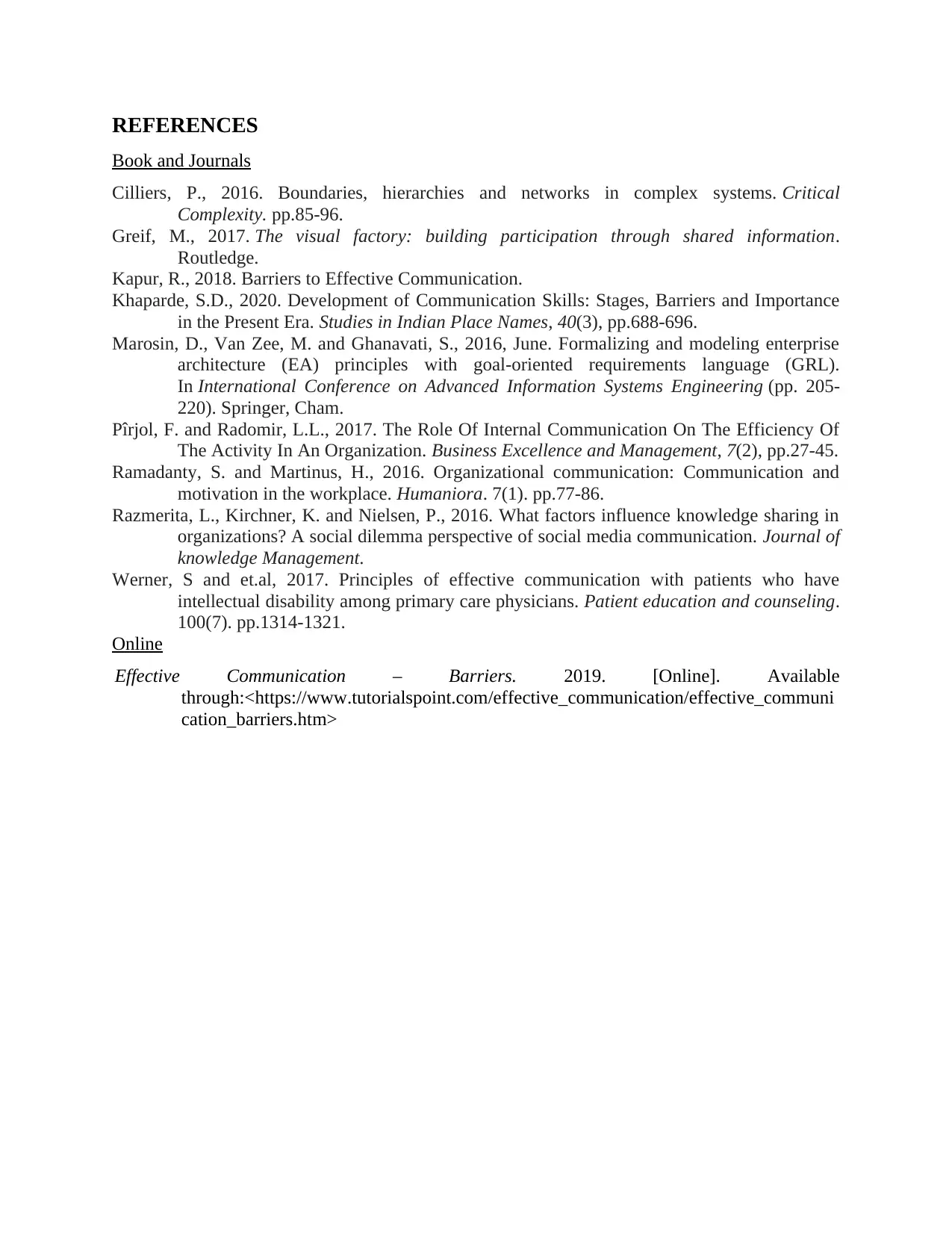Business Communication: Overcoming Challenges and Enhancing Practices
VerifiedAdded on 2023/01/13
|10
|2132
|22
Report
AI Summary
This report delves into the multifaceted realm of business communication, emphasizing its critical role in organizational success and productivity. It examines various forms of organizational communication, including formal and informal channels, internal and external communication, and their respective purposes. The report identifies challenges like lack of information and hierarchical gaps that hinder effective communication, especially between drivers and consumers and with top management. It analyzes these barriers and provides actionable recommendations to enhance communication, such as acquiring knowledge of services, conducting regular meetings, and fostering open communication channels. The report concludes by highlighting the importance of face-to-face meetings and adherence to communication principles to overcome challenges and foster effective relationships within the workplace, ultimately improving business outcomes. Relevant literature review and references are also included.

BUSINESS
COMMUNICATION
COMMUNICATION
Paraphrase This Document
Need a fresh take? Get an instant paraphrase of this document with our AI Paraphraser

Abstract-
Business communication is a two-way procedure of speaking and listening, it is
extremely essential for companies success as well as productivity. This report has been analysed
that lack of knowledge and hierarchy gap make challenges to effective communication, by
understanding and getting knowledge of work driver effectively overcome challenge and
communicate number of consumers. Furthermore, it has been justified that through meeting top
management give change to make effective communication and reduce gap.
Business communication is a two-way procedure of speaking and listening, it is
extremely essential for companies success as well as productivity. This report has been analysed
that lack of knowledge and hierarchy gap make challenges to effective communication, by
understanding and getting knowledge of work driver effectively overcome challenge and
communicate number of consumers. Furthermore, it has been justified that through meeting top
management give change to make effective communication and reduce gap.

Table of Contents
INTRODUCTION...........................................................................................................................4
LITERATURE REVIEW................................................................................................................4
Purpose and principles behind different forms of organizational communication......................4
Principles of effective communication to enhance practices.......................................................5
Challenges and barriers of effective communication...................................................................6
ANALYSIS AND DISCUSSION...................................................................................................6
RECOMMENDATION...................................................................................................................7
CONCLUSION................................................................................................................................7
REFERENCES ...............................................................................................................................8
INTRODUCTION...........................................................................................................................4
LITERATURE REVIEW................................................................................................................4
Purpose and principles behind different forms of organizational communication......................4
Principles of effective communication to enhance practices.......................................................5
Challenges and barriers of effective communication...................................................................6
ANALYSIS AND DISCUSSION...................................................................................................6
RECOMMENDATION...................................................................................................................7
CONCLUSION................................................................................................................................7
REFERENCES ...............................................................................................................................8
⊘ This is a preview!⊘
Do you want full access?
Subscribe today to unlock all pages.

Trusted by 1+ million students worldwide

INTRODUCTION
Business communication define exchange information in order to promote organizational
aims, activities and objectives as it help to increase profitability. The present report is based on
organizational communication, it explains their forms of organizational communication and its
principles. Furthermore, this study justified challenges and barriers to effective communication
faced by driver while communicating with consumers and top management.
LITERATURE REVIEW
Purpose and principles behind different forms of organizational communication
As per view of Greif, (2017) organizational communication is procedure of exchanging
information, sharing views and ideas within company. It indicates interaction not only in context
of business but also in other institutions. It is significant for workers in company to perform
basic activities of management for example, leading, planning, organizing and controlling. On
the other hand, Razmerita, Kirchner and Nielsen, (2016) highlighted that organization
communication is defined as forms and channels of communication that occurs within firms such
as governmental and non-profits bodies. It considered as procedure by which team of people
convey aims and objectives of business and way to reach them. Formal and informal
communication is one of the organizational communication type that helps to make effective
interaction between team members. The purpose of formal communication is to fulfil the
objectives of company, give orders and convey instruction through some pre-determined
regulations. On the other side, informal communication purpose is different from other forms of
organizational communication, it includes sharing of information developing personal contacts,
influencing and inspiring others, supplementing official channels, making friendship and
searching escape from monotony of work.
According to Ramadanty and Martinus, (2016) organizational communication is divided
into many forms, for example internal and external communication. Internal communication
purpose is to assure that all the workers in company had information and knowledge they need to
work towards and effectively achieved common goal. External communication is another kind of
organizational communication, its purpose is to cater info to consumers about specific services
and products offered by firm.
Marosin, Van Zee and Ghanavati, (2016) discussed that in formal communication, certain
principles and rules are followed while communicating message. Flaw of data is controlled and
Business communication define exchange information in order to promote organizational
aims, activities and objectives as it help to increase profitability. The present report is based on
organizational communication, it explains their forms of organizational communication and its
principles. Furthermore, this study justified challenges and barriers to effective communication
faced by driver while communicating with consumers and top management.
LITERATURE REVIEW
Purpose and principles behind different forms of organizational communication
As per view of Greif, (2017) organizational communication is procedure of exchanging
information, sharing views and ideas within company. It indicates interaction not only in context
of business but also in other institutions. It is significant for workers in company to perform
basic activities of management for example, leading, planning, organizing and controlling. On
the other hand, Razmerita, Kirchner and Nielsen, (2016) highlighted that organization
communication is defined as forms and channels of communication that occurs within firms such
as governmental and non-profits bodies. It considered as procedure by which team of people
convey aims and objectives of business and way to reach them. Formal and informal
communication is one of the organizational communication type that helps to make effective
interaction between team members. The purpose of formal communication is to fulfil the
objectives of company, give orders and convey instruction through some pre-determined
regulations. On the other side, informal communication purpose is different from other forms of
organizational communication, it includes sharing of information developing personal contacts,
influencing and inspiring others, supplementing official channels, making friendship and
searching escape from monotony of work.
According to Ramadanty and Martinus, (2016) organizational communication is divided
into many forms, for example internal and external communication. Internal communication
purpose is to assure that all the workers in company had information and knowledge they need to
work towards and effectively achieved common goal. External communication is another kind of
organizational communication, its purpose is to cater info to consumers about specific services
and products offered by firm.
Marosin, Van Zee and Ghanavati, (2016) discussed that in formal communication, certain
principles and rules are followed while communicating message. Flaw of data is controlled and
Paraphrase This Document
Need a fresh take? Get an instant paraphrase of this document with our AI Paraphraser

well-balanced by company hierarchy, due to appropriate control, info will be delivered at desired
area without breaking flow, it considered as the principle of formal communication. Information
communication approach have no principles structure, it typically goes randomly from one
subject to another, this is why it is often called grapevine in work area because data is passed on
frequently from one individual to another just like a grapevine grows.
Pîrjol and Radomir, (2017) stated that internal communication is transmission of data
between departments of company or organizational members. Transparency is the principle of
highly effective information communication method, while interacting with others, person must
be honest. However, principle of external communication is different from above forms of
organizational communication. It includes key activities in cut over plan will be highlighted,
once complete, email interaction will be set to agreed distribution list to inform on growth.
Principles of effective communication to enhance practices
According to Khaparde, (2020) effective communication is defined as non-verbal and
verbal speech of relating data that obtain a point across. An example of effective communication
is when people talk in simple and clear terms. The main purpose of communication is exchange
of information and ideas among number of people working in companies. A sender, however
will have knowledge of some peculiar facts which they will use in specific situation to make
communication highly effective, these special facts are known as the principles of effective
communication, it comprises with 13 principles. Clarity of ideas is the first principle, according
to it, sender create clear picture in their mind as what they want to say to other before start
practising. Second one is appropriate language, accordant to this principle, communication will
always be in simple tone, ideas will be clear and be devoid of any doubt. People use technical
words that make communication effective rather than before. Third principle is attention,
purpose of connection is that receiver of info will clearly comprehend their meaning. It is very
essential that receiver pay attention while communicating with other that help to understand it
properly. They have to takes interest in message and listens to it carefully without losing focus.
Along with it, consistency is the fourth principle of effective communication, define that
interaction system will maintain consistency in objectives of business, and their procedures,
which means communication must be in according to policies laid down for it.
Werner and et.al., (2017) cited that all the principles are highly important for
communication. The fifth principle is adequacy, information sent to other will be complete and
area without breaking flow, it considered as the principle of formal communication. Information
communication approach have no principles structure, it typically goes randomly from one
subject to another, this is why it is often called grapevine in work area because data is passed on
frequently from one individual to another just like a grapevine grows.
Pîrjol and Radomir, (2017) stated that internal communication is transmission of data
between departments of company or organizational members. Transparency is the principle of
highly effective information communication method, while interacting with others, person must
be honest. However, principle of external communication is different from above forms of
organizational communication. It includes key activities in cut over plan will be highlighted,
once complete, email interaction will be set to agreed distribution list to inform on growth.
Principles of effective communication to enhance practices
According to Khaparde, (2020) effective communication is defined as non-verbal and
verbal speech of relating data that obtain a point across. An example of effective communication
is when people talk in simple and clear terms. The main purpose of communication is exchange
of information and ideas among number of people working in companies. A sender, however
will have knowledge of some peculiar facts which they will use in specific situation to make
communication highly effective, these special facts are known as the principles of effective
communication, it comprises with 13 principles. Clarity of ideas is the first principle, according
to it, sender create clear picture in their mind as what they want to say to other before start
practising. Second one is appropriate language, accordant to this principle, communication will
always be in simple tone, ideas will be clear and be devoid of any doubt. People use technical
words that make communication effective rather than before. Third principle is attention,
purpose of connection is that receiver of info will clearly comprehend their meaning. It is very
essential that receiver pay attention while communicating with other that help to understand it
properly. They have to takes interest in message and listens to it carefully without losing focus.
Along with it, consistency is the fourth principle of effective communication, define that
interaction system will maintain consistency in objectives of business, and their procedures,
which means communication must be in according to policies laid down for it.
Werner and et.al., (2017) cited that all the principles are highly important for
communication. The fifth principle is adequacy, information sent to other will be complete and

sufficient in every respect, in context of companies, sufficient data depends on capability of
receiver. When receiver happens to be able more info will be given with the help of few words.
Proper time is the sixth principles, states that message will reach receiver whenever they are
required, without delay. Hence, content will be sent before actual need keeping in mind of person
at time required for communication. Informality is the seventh principle, according to it, informal
communication will be given recognition in company, it cannot be able to solve issues, but with
formal communication problems will be solved effectively that helps to make effective
connection between workers. Eight principle is feedback, it is very important for sender of
information that they will know about success of message, feedback is one of the most easily
obtained in effective face to face communication with the help of facial reactions of receiver.
Ninth principle is integration, according to this communication will be able to introduce all
people in company with clean objectives so that all workers move untidily towards specific goal.
Tenth principle is consultation, recommendations of all workers concerned must be invited while
making strategies for communication, it will help to success of communication process. Eleventh
principle is flexibility, accordant to this, interaction system will be able to absorb changes in
workplace which is essential, when it does not absorb modification according to need it becomes
meaningless. Twelve principle is economy, communication process will not be unnecessarily
costly, unessential information must be reduced to enhance ability to make communication
economical. Thirteen principle is proper medium, according to which people make proper choice
of medium to make communication effective.
Challenges and barriers of effective communication
According to the Kapur, (2018) people face different challenges and barriers while
making effective communication. Lack of information is one of the challenge that impact on
effective interaction between two people or group. Without having knowledge of specific things,
people cannot be able to make effective communication Cilliers, (2016) elucidated that due to
hierarchy gap good communication is not possible it is one of the biggest challenges faced while
interaction.
ANALYSIS AND DISCUSSION
From above analysis, it has been analysed that lack of information is one of the barrier
that put impact on effective communication. For example, without getting information about
services and products driver cannot be able to communicate with their consumers effectively. It
receiver. When receiver happens to be able more info will be given with the help of few words.
Proper time is the sixth principles, states that message will reach receiver whenever they are
required, without delay. Hence, content will be sent before actual need keeping in mind of person
at time required for communication. Informality is the seventh principle, according to it, informal
communication will be given recognition in company, it cannot be able to solve issues, but with
formal communication problems will be solved effectively that helps to make effective
connection between workers. Eight principle is feedback, it is very important for sender of
information that they will know about success of message, feedback is one of the most easily
obtained in effective face to face communication with the help of facial reactions of receiver.
Ninth principle is integration, according to this communication will be able to introduce all
people in company with clean objectives so that all workers move untidily towards specific goal.
Tenth principle is consultation, recommendations of all workers concerned must be invited while
making strategies for communication, it will help to success of communication process. Eleventh
principle is flexibility, accordant to this, interaction system will be able to absorb changes in
workplace which is essential, when it does not absorb modification according to need it becomes
meaningless. Twelve principle is economy, communication process will not be unnecessarily
costly, unessential information must be reduced to enhance ability to make communication
economical. Thirteen principle is proper medium, according to which people make proper choice
of medium to make communication effective.
Challenges and barriers of effective communication
According to the Kapur, (2018) people face different challenges and barriers while
making effective communication. Lack of information is one of the challenge that impact on
effective interaction between two people or group. Without having knowledge of specific things,
people cannot be able to make effective communication Cilliers, (2016) elucidated that due to
hierarchy gap good communication is not possible it is one of the biggest challenges faced while
interaction.
ANALYSIS AND DISCUSSION
From above analysis, it has been analysed that lack of information is one of the barrier
that put impact on effective communication. For example, without getting information about
services and products driver cannot be able to communicate with their consumers effectively. It
⊘ This is a preview!⊘
Do you want full access?
Subscribe today to unlock all pages.

Trusted by 1+ million students worldwide

will contribute to poor productivity and decrease profitability. When sender had little knowledge
about subject matter of message sent, they fail to provide it in desired as well as effective
manner. It also leads to poor interactions and ineffective outcomes during communications with
consumers. Lack of knowledge in consumers services and other business practices is also a
major barrier in understanding the message.
Along with it, more challenges faced by driver while making effective communication
with top management. Business Hierarchy create gap between all the department, it affects
communication process negatively, as workers cannot be able to feel free for making discussion
on specific top. It defines as one of the largest barrier to good communication that might be
directly impact on work place environment and demotivate all the staff members which decrease
their performance.
RECOMMENDATION
To overcome barrier to effective communication driver recommended understanding all
essential features and aspects of services that help to enhance their ability while
communicating with consumers. With the method they can gain the attention of
customers and make good relationship with them which is beneficial in context of
business as it increases consumers base rather than before.
Knowledge acquisition is one of the most important think for driver which they had to
consider before making communication with its clients. Knowledge directly connected to
communication, driver must get higher knowledge about everything for example about
consumers, which make them capable to put good impression on third person and allow
them to convey content in way that is easily comprehended by other.
It is very difficult for workers to communicate with top management effectively, firm
should understand this barrier and make effective strategy. Once in week, they must
conduct a group meeting where all the people get opportunity to share their feelings and
give point of view about work in front of top management, it helps to overcome barriers.
CONCLUSION
From above analysis, it has been summarized that by following recommended
suggestions, it is easy for driver to overcome barriers in effective communication. Face to face
meeting is the best way to overcome challenges as it help in building effective relationship at
workplace.
about subject matter of message sent, they fail to provide it in desired as well as effective
manner. It also leads to poor interactions and ineffective outcomes during communications with
consumers. Lack of knowledge in consumers services and other business practices is also a
major barrier in understanding the message.
Along with it, more challenges faced by driver while making effective communication
with top management. Business Hierarchy create gap between all the department, it affects
communication process negatively, as workers cannot be able to feel free for making discussion
on specific top. It defines as one of the largest barrier to good communication that might be
directly impact on work place environment and demotivate all the staff members which decrease
their performance.
RECOMMENDATION
To overcome barrier to effective communication driver recommended understanding all
essential features and aspects of services that help to enhance their ability while
communicating with consumers. With the method they can gain the attention of
customers and make good relationship with them which is beneficial in context of
business as it increases consumers base rather than before.
Knowledge acquisition is one of the most important think for driver which they had to
consider before making communication with its clients. Knowledge directly connected to
communication, driver must get higher knowledge about everything for example about
consumers, which make them capable to put good impression on third person and allow
them to convey content in way that is easily comprehended by other.
It is very difficult for workers to communicate with top management effectively, firm
should understand this barrier and make effective strategy. Once in week, they must
conduct a group meeting where all the people get opportunity to share their feelings and
give point of view about work in front of top management, it helps to overcome barriers.
CONCLUSION
From above analysis, it has been summarized that by following recommended
suggestions, it is easy for driver to overcome barriers in effective communication. Face to face
meeting is the best way to overcome challenges as it help in building effective relationship at
workplace.
Paraphrase This Document
Need a fresh take? Get an instant paraphrase of this document with our AI Paraphraser

REFERENCES
Book and Journals
Cilliers, P., 2016. Boundaries, hierarchies and networks in complex systems. Critical
Complexity. pp.85-96.
Greif, M., 2017. The visual factory: building participation through shared information.
Routledge.
Kapur, R., 2018. Barriers to Effective Communication.
Khaparde, S.D., 2020. Development of Communication Skills: Stages, Barriers and Importance
in the Present Era. Studies in Indian Place Names, 40(3), pp.688-696.
Marosin, D., Van Zee, M. and Ghanavati, S., 2016, June. Formalizing and modeling enterprise
architecture (EA) principles with goal-oriented requirements language (GRL).
In International Conference on Advanced Information Systems Engineering (pp. 205-
220). Springer, Cham.
Pîrjol, F. and Radomir, L.L., 2017. The Role Of Internal Communication On The Efficiency Of
The Activity In An Organization. Business Excellence and Management, 7(2), pp.27-45.
Ramadanty, S. and Martinus, H., 2016. Organizational communication: Communication and
motivation in the workplace. Humaniora. 7(1). pp.77-86.
Razmerita, L., Kirchner, K. and Nielsen, P., 2016. What factors influence knowledge sharing in
organizations? A social dilemma perspective of social media communication. Journal of
knowledge Management.
Werner, S and et.al, 2017. Principles of effective communication with patients who have
intellectual disability among primary care physicians. Patient education and counseling.
100(7). pp.1314-1321.
Online
Effective Communication – Barriers. 2019. [Online]. Available
through:<https://www.tutorialspoint.com/effective_communication/effective_communi
cation_barriers.htm>
Book and Journals
Cilliers, P., 2016. Boundaries, hierarchies and networks in complex systems. Critical
Complexity. pp.85-96.
Greif, M., 2017. The visual factory: building participation through shared information.
Routledge.
Kapur, R., 2018. Barriers to Effective Communication.
Khaparde, S.D., 2020. Development of Communication Skills: Stages, Barriers and Importance
in the Present Era. Studies in Indian Place Names, 40(3), pp.688-696.
Marosin, D., Van Zee, M. and Ghanavati, S., 2016, June. Formalizing and modeling enterprise
architecture (EA) principles with goal-oriented requirements language (GRL).
In International Conference on Advanced Information Systems Engineering (pp. 205-
220). Springer, Cham.
Pîrjol, F. and Radomir, L.L., 2017. The Role Of Internal Communication On The Efficiency Of
The Activity In An Organization. Business Excellence and Management, 7(2), pp.27-45.
Ramadanty, S. and Martinus, H., 2016. Organizational communication: Communication and
motivation in the workplace. Humaniora. 7(1). pp.77-86.
Razmerita, L., Kirchner, K. and Nielsen, P., 2016. What factors influence knowledge sharing in
organizations? A social dilemma perspective of social media communication. Journal of
knowledge Management.
Werner, S and et.al, 2017. Principles of effective communication with patients who have
intellectual disability among primary care physicians. Patient education and counseling.
100(7). pp.1314-1321.
Online
Effective Communication – Barriers. 2019. [Online]. Available
through:<https://www.tutorialspoint.com/effective_communication/effective_communi
cation_barriers.htm>

⊘ This is a preview!⊘
Do you want full access?
Subscribe today to unlock all pages.

Trusted by 1+ million students worldwide

1 out of 10
Related Documents
Your All-in-One AI-Powered Toolkit for Academic Success.
+13062052269
info@desklib.com
Available 24*7 on WhatsApp / Email
![[object Object]](/_next/static/media/star-bottom.7253800d.svg)
Unlock your academic potential
Copyright © 2020–2025 A2Z Services. All Rights Reserved. Developed and managed by ZUCOL.





